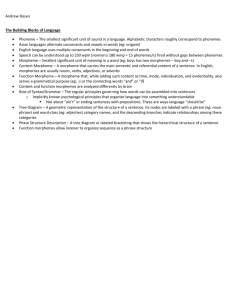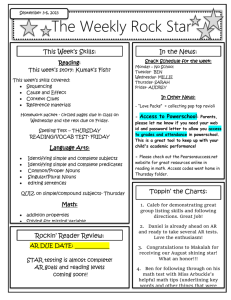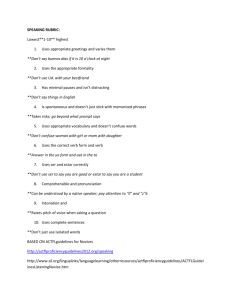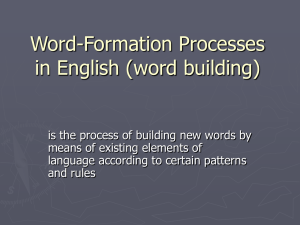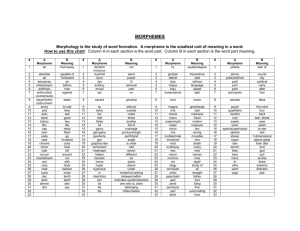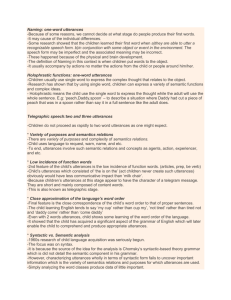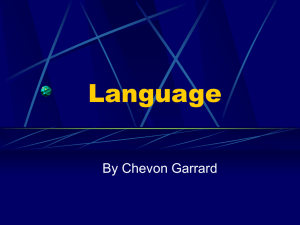Is One Language Sample Enough in Morphosyntactic Analysis?
advertisement
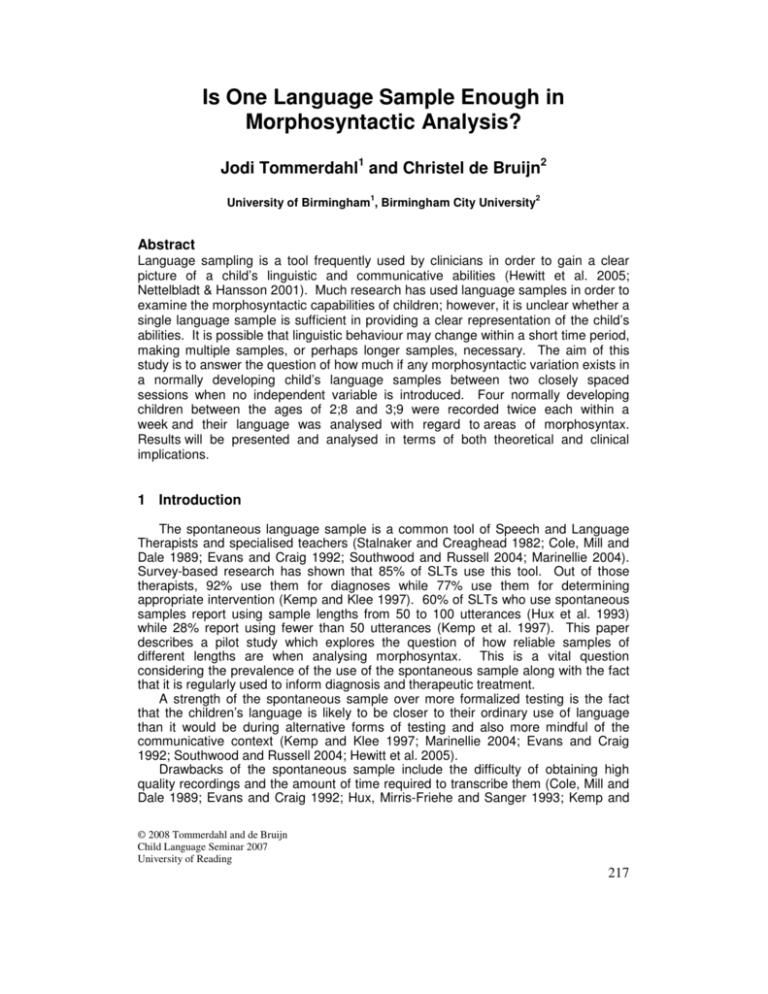
Is One Language Sample Enough in Morphosyntactic Analysis? Jodi Tommerdahl1 and Christel de Bruijn2 University of Birmingham1, Birmingham City University2 Abstract Language sampling is a tool frequently used by clinicians in order to gain a clear picture of a child’s linguistic and communicative abilities (Hewitt et al. 2005; Nettelbladt & Hansson 2001). Much research has used language samples in order to examine the morphosyntactic capabilities of children; however, it is unclear whether a single language sample is sufficient in providing a clear representation of the child’s abilities. It is possible that linguistic behaviour may change within a short time period, making multiple samples, or perhaps longer samples, necessary. The aim of this study is to answer the question of how much if any morphosyntactic variation exists in a normally developing child’s language samples between two closely spaced sessions when no independent variable is introduced. Four normally developing children between the ages of 2;8 and 3;9 were recorded twice each within a week and their language was analysed with regard to areas of morphosyntax. Results will be presented and analysed in terms of both theoretical and clinical implications. 1 Introduction The spontaneous language sample is a common tool of Speech and Language Therapists and specialised teachers (Stalnaker and Creaghead 1982; Cole, Mill and Dale 1989; Evans and Craig 1992; Southwood and Russell 2004; Marinellie 2004). Survey-based research has shown that 85% of SLTs use this tool. Out of those therapists, 92% use them for diagnoses while 77% use them for determining appropriate intervention (Kemp and Klee 1997). 60% of SLTs who use spontaneous samples report using sample lengths from 50 to 100 utterances (Hux et al. 1993) while 28% report using fewer than 50 utterances (Kemp et al. 1997). This paper describes a pilot study which explores the question of how reliable samples of different lengths are when analysing morphosyntax. This is a vital question considering the prevalence of the use of the spontaneous sample along with the fact that it is regularly used to inform diagnosis and therapeutic treatment. A strength of the spontaneous sample over more formalized testing is the fact that the children’s language is likely to be closer to their ordinary use of language than it would be during alternative forms of testing and also more mindful of the communicative context (Kemp and Klee 1997; Marinellie 2004; Evans and Craig 1992; Southwood and Russell 2004; Hewitt et al. 2005). Drawbacks of the spontaneous sample include the difficulty of obtaining high quality recordings and the amount of time required to transcribe them (Cole, Mill and Dale 1989; Evans and Craig 1992; Hux, Mirris-Friehe and Sanger 1993; Kemp and © 2008 Tommerdahl and de Bruijn Child Language Seminar 2007 University of Reading 217 Klee 1997). Possibly a more serious drawback to the use of language samples is our lack of knowledge regarding what length or what number of samples are necessary in order to be representative of a child’s language (Wren 1985; Cole, Mill and Dale 1989; Gregg and Andrews 1995; Scott 1995; Gavin and Giles 1997; Marinellie 2004). It is to be expected that different linguistic areas will require different sample lengths or numbers. For example, pragmatics could easily be predicted to require more and/or longer samples than would phonology if asked to provide a reliable picture of an individual’s linguistic production. 1.1 The notion of reliability Reliability is a vital measure that is required if an assessment is to be considered appropriate. It reassures professionals that the tool they are using will give very similar results repeatedly when used in identical conditions. Only if scores are consistent along with performance, are the results useful to the SLT or researcher. Unfortunately, very little has been done in this field in regard to spontaneous language samples. Cole et al (1989) makes the point that “Although reliability information is basic to the interpretation of test results, this measurement characteristic appears to have been generally overlooked in the area of language sample interpretation.” Marinellie (2004) takes the same view, stating, “Currently, it is unknown whether an ordinary language sample is adequate to yield most types of spoken syntactic complexity” and calls sample reliability in regard to syntax “a relatively uncharted area” both for typically developing children along with children with SLI. A further difficulty of the spontaneous sample is the lack of availability of datasets showing the number of particular morphosyntactic structures typical for children at defined ages. Hewitt, Hammer, Yont and Tomblin (2005) have called not only for these datasets to be assembled but also speak of the necessity of doing the same for children with language impairments so that their datasets could be compared. A small database representative of typically developing children’s MLU, word useage, and bound morpheme counts has been established for children aged 3-13 based on 100-utterance samples (Leadholm and Miller 1994). However, only one sample length is represented and no test-retest procedure was carried out which could have informed the question of how reliable the samples were. Considering the desire of researchers to possess datasets for various ages, various aspects of language, and for both children who are typically developing and for those with language impairments (Eisenberg 2001; Hewitt et al. 2005), there are many places where this research could begin. This project focuses on morphosyntax because it is known to be an area of difficulty in language impairment, particularly in Specific Language Impairment (Yoder 1989; Gopnik and Crago 1991; Rice, Wexler and Cleave 1995; Leonard 1998) and has been proposed as a possible key to the diagnosis of SLI (Rice and Wexler 1996; Leonard 1998). The dataset proposed could provide a tool helpful in analysing theories of this sort. 1.2 Reliability studies in the areas of syntax and morphology A study by Johnson and Tomblin (1975) examined the question of reliability in regard to the Developmental Sentence Scoring assessment (Lee 1974) which recommends that a sample of 50 utterances be collected to test the syntactic and morphological development of children. Their research examined reliability coefficients based on 5 to 250 utterances and their findings suggested that 175 utterances needed to be gathered in order to surpass a coefficient of 0.90. 218 Gavin and Giles (1997) similarly tested language samples of up to 175 utterances and reported that a coefficient of .90 wasn’t reached in any area until 175 utterances were used. However, Muma’s study of samples up to 400 utterances (1998) finds that 200-300 sentences are needed to accurately assess the use of most grammatical repertoires. Marinellie (2004) investigated the use of language samples for syntactic complexity with 15 children with SLI and 15 with typically developing language with a mean age of 10;8. Findings showed that the SLI group produced some examples of most of the structures, but fewer of each kind than the typically developing group, sometimes only producing one example of a structure per sample. Marinellie calls the reliability of the sample size into question and calls for further investigations into the reliability of varied length samples, also suggesting a test-retest methodology for future studies. Evans and Craig (1992) reiterate this idea, stating that more than one sample may be needed to ensure that the language sampled is representative of the child’s naturally occurring language. Cole, Mills and Dale (1989) used the test-retest procedure in order to gauge the reliability of language samples of 10 children with mild to moderate developmental delay ranging in age from 4;4 to 6;8. Using 2 20-minute long samples, taken within 2 weeks of each other in identical settings, they looked specifically at MLU, question use, and morphological production of the past tense, regular plural and present progressive. Findings showed low correlations for these categories (questions .13, past tense .28, regular plural .50 and present progressive .16). Although samples were measured by time instead of utterances, each sample was over 100 utterances in length. This paper concludes that “additional information about the reliability of measure derived from samples is needed.” The rest of the current paper presents a pilot study which gathered repeated language samples of typically developing children from 2;6 – 3;6 in order to determine the correlation of various morphosyntactic features at sample lengths of 50, 100, 150 and 200 utterances. It is hoped that this information will lay the groundwork for a larger study, provide the beginnings of a dataset of typically developing children and shed light onto the question of how reliable spontaneous language samples of different lengths are. 2 Method 2.1 Participants Participants for the pilot study consisted of 3 girls and 1 boy ranging in age from 2;8-3;9 (mean 36.5 months) from the local community who were considered as typically developing based on the following criteria: 1) the children had normal hearing levels 2) the children had never been referred to speech and language therapy 3) the children’s parents were not aware of any language or communication difficulties of their children 4) parents reported the absence of any neurological disorders. All of the children were from monolingual English backgrounds. 2.2 Procedure Naturalistic language samples were gathered at a recording studio on two occasions, a maximum of a week apart. This was to minimise the effect of language learning on the samples. The context of the two sessions were kept as near identical as possible so as not to introduce any extraneous variables. Each parent provided informed consent and was escorted with their child into a playroom housing a large selection of toys. The carer and the child played normally for approximately 35 219 minutes. Each parent was instructed to spend at least five minutes if possible discussing a recent occurrence that had taken place before the session. This was to encourage the child to use a wider range of verb tenses than they might have done otherwise (Crystal 1982, p.14). The playroom was a Flexible Learning Room fitted with five hidden cameras and a host of media systems controlled from the adjacent control gallery. All sessions were transcribed in their totality by a single transcriber. Each utterance was then analysed according to the morphosyntactic structures listed in the Word section of the Language Assessment and Remediation Screening Programme (LARSP) (Crystal, Fletcher and Garman 1976). Each usage of a morpheme from this list was counted for 200 utterances of each child. Table 1. morphemes from the LARSP Word Examples -ing pl -ed -en 3s gen n’t ‘cop ‘aux -est -er -ly Mummy eating/ all the cows/ I found it/ have you eaten/ my cat sits on a chair/ I see the farmer’s cow/ don’t/ it’s big/ I’m counting/ the biggest cup/ bigger one/ he go quickly/ 3 Results Results are presented here in two brief sections. First, the raw data from each of the four children will be presented, followed by discussion of the correlation. A descriptive view of the data is provided in the following Discussion section. 3.1 Raw data The data from this section is cumulative, meaning that Child E produced four instances of the –ing morpheme in the first 50 utterances analysed and then five more in the next 50 utterances, etc. 220 Table 2. morpheme production for child E child E age 2;8 sample 1 50 100 150 200 -ing 4 9 16 18 pl 2 10 15 17 -ed 0 0 1 2 -en 0 0 2 2 3s 0 0 0 0 gen 0 1 1 3 n’t 0 0 0 1 ‘cop 6 9 16 17 ‘aux 3 5 11 13 -er 0 0 0 1 -est 0 0 0 0 -ly 1 1 1 1 Table 3. morpheme production for child F child F age 2;10 sample 1 50 100 150 200 -ing 3 6 11 12 pl 5 9 10 11 -ed 0 0 1 1 -en 1 1 1 1 3s 1 2 3 3 gen 3 3 4 4 n’t 3 4 7 15 ‘cop 7 14 19 24 ‘aux 2 5 8 8 -er 0 0 0 0 -est 0 0 0 0 -ly 0 0 0 0 Table 4. morpheme production for child J child J age 2;11 sample 1 50 100 150 200 -ing 2 6 8 10 pl 6 9 10 12 -ed 4 8 9 10 -en 2 2 3 5 3s 1 2 3 11 gen 0 0 0 0 n’t 1 4 5 9 ‘cop 17 28 38 45 ‘aux 4 5 9 15 -er 0 0 0 0 -est 0 0 0 0 -ly 0 0 0 0 2 2 0 0 0 0 0 5 2 0 0 0 sample 2 100 150 2 1 0 0 0 0 0 7 2 0 0 0 6 9 0 0 0 0 0 11 6 0 0 0 6 0 1 0 5 1 3 3 3 0 0 0 sample 2 100 150 11 3 2 0 5 1 8 13 7 0 0 0 20 4 5 0 5 1 8 15 11 0 0 1 3 4 0 1 1 0 5 4 6 0 0 0 sample 2 100 150 7 6 0 2 1 0 8 12 10 0 0 0 8 6 0 3 1 0 14 21 11 0 0 0 50 -ing pl -ed -en 3s gen n’t ‘cop ‘aux -er -est -ly 50 -ing pl -ed -en 3s gen n’t ‘cop ‘aux -er -est -ly 50 -ing pl -ed -en 3s gen n’t ‘cop ‘aux -er -est -ly 200 7 9 0 0 0 0 0 14 8 0 0 0 200 28 9 7 4 6 1 8 18 17 0 0 1 200 10 7 0 4 3 1 23 26 15 0 0 0 221 Table 5. morpheme production for child M child M age 3;9 sample 1 50 100 150 200 -ing 2 5 9 11 pl 4 7 10 13 -ed 1 3 10 12 -en 2 3 3 3 3s 3 3 4 5 gen 0 0 3 3 n’t 7 12 17 21 ‘cop 5 9 10 14 ‘aux 4 6 9 11 -er 0 0 0 0 -est 0 0 0 0 -ly 0 0 0 0 50 -ing pl -ed -en 3s gen n’t ‘cop ‘aux -er -est -ly 5 2 0 2 5 0 5 1 4 0 0 1 sample 2 100 150 11 2 0 2 7 2 7 11 6 3 0 2 200 25 3 7 2 8 7 10 14 22 3 0 2 29 7 9 3 8 7 15 16 27 3 0 2 3.2 Correlation Table 6. correlation results for all children 50 100 -ing -.381 -.924 pl .239 .725 -ed -.440 -.486 -en .818 .894 3s .730 .822 gen 1.00** .000 n’t -.604 .566 ‘cop .360 .494 aux .663 -.050 -er . . -est . . -ly -.333 -.333 150 -.477 .882 .228 .890 .781 .488 .508 .876 -.451 . . -.522 200 -.499 .329 .192 .284 .210 .150 .449 .970** -.359 -.333 . -.522 *Correlation is significant at the 0.05 level (2-tailed). ** Correlation is significant at the 0.01 level (2-tailed). . Cannot be computed because at least one of the variables is constant. Table 6 displays the correlation for each morpheme between the first and second samples for the four children. As there are only four children, it is not surprising that the correlations are unstable. The morpheme -en displays high correlations for 50, 100 and 150 utterances, suggesting that this may be a reliable measure of linguistic development. However, the correlation falls from above 0.8 down to just 0.284 with 200 utterances. Inspection of tables A to D, shows this is due to child F producing 4 –en morphemes in the last 50 utterances of sample 2 despite only producing one such morpheme in the previous 350 utterances. Out of the morphemes examined, only the contracted copular has a correlation that moves consistently higher with longer samples. This is likely to be due to the fact that it was produced a relatively large number of times (174) in comparison to other morphemes were produced relatively few times and had much less consistent correlations. 222 Table 6 shows two of the correlations of morphemes to have reached statistical significance with the result for the genitive being doubtful as three of the children gave zero responses for both samples. The contracted copular is more promising, however, as it is based on much greater use. It is expected that correlation studies in an upcoming project with 25 children will be more informative. 4 Discussion This pilot study draws attention to information that is useful for those using spontaneous language samples. Most striking is the uneven distribution of given morphemes throughout an individual sample. This is exemplified by child J’s use of the third person singular which she uses once in each of the first three groupings of 50 utterances. She then goes on to use it eight times in the last group. The unevenness of the spread of a given morpheme throughout a sample repeatedly leads to the situation where if one shorter sample of 50 or 100 utterances had been analysed on its own, the morpheme may have been completely absent despite the fact that a longer sample of 200 utterances showed it to be present. This deserves special attention considering that the presence versus the absence of morphemes is likely to draw more attention to a possible sign of difficulty than a perceived underuse of a morpheme, particularly when diagnostic and therapeutic decisions are being made. The table below shows the frequency of this phenomenon. In the case of child E, this happens for six out of the twelve morphemes at the 50 utterance size and for three out of twelve when considering 100 utterances. Unsurprisingly, the errors reduce in line with the expansion of the sample size considered. Table 7. Errors regarding the presence vs absence of a morpheme Errors at 50 Errors at 100 child E 6 3 child F 5 2 child J 1 0 child M 3 1 5 Conclusion The analysis of spontaneous language samples is very popular among language researchers and practitioners due to the freedom of production that it affords the child. However, almost no research has been carried out into the reliability of the language sample in the field of morphosyntactic analysis. Given the fact that language samples are often used to diagnose language difficulties and to plan therapy, research into the degree of reliability provided by these samples is vital. The main finding from this pilot study is the unevenness of the distribution of most morphemes throughout a 200 utterance language sample. Samples of 50 and 100 utterances were often shown to be inaccurate regarding the presence or absence of a particular morpheme in an individual’s productive repertoire. This pilot project is currently being expanded into a larger one analysing 25 typically developing children and a larger set of morphemes. Besides analysing the reliability of morphosyntactic production, a database of norms for different sized language samples will also be developed. It is intended that both aspects of this study will be of assistance to future researchers and practitioners comparing the linguistic production of typically developing children with those who are language impaired. 223 Acknowledgements The authors would like to thank the University of Birmingham’s School of Education for a Small Research Grant. References Cole, K. N., Mills, P. E. and Dale, P. S. (1989). Examination of test-retest and split-half reliability for measures derived from language samples of young handicapped children. Language, Speech and Hearing Services in Schools 20, 259-268. Crystal, D. (1982). Profiling linguistic disability. London: Edward Arnold. Crystal, D., Garman, M. and Fletcher, P. (1976). The grammatical analysis of language disability: A procedure for assessment and remediation (2nd ed) London: Cole and Whurr. Eisenberg, S., Fersko, T. and Lundgren, C. (2001). The use of MLU for identifying language impairment in preschool children: A review. American Journal of Speech-Language Pathology 10, 323-342. Evans, J. L. and Craig, H. K. (1992). Language sample collection and analysis: Interview compared to freeplay assessment contexts. Journal of Speech and Hearing Research 35(2), 343-353. Gavin, W. J. and Giles, L. (1996) Sample size effects on temporal reliability of language sample measures of preschool children. Journal of Speech and Hearing Research 39, 1258-1262. Gopnik, M. and Crago, M. (1991). Familial aggregation of developmental language disorder. Cognition 39, 1-50. Gregg, E. M. and Andrews, V. (1995). Review of computerized profiling. Child Teaching and Language Therapy 11, 209-216. Hewitt, L.E., Hammer, C.S., Yont, K.M. and Tomblin, J. B. (2005). Language sampling for kindergarten children with and without SLI: mean length of utterance, IPSYN, and NDW. Journal of Communication Disorders 38, 197-213. Hux, K., Morris-Friehe, M. and Sanger, D.D. (1993). Language sampling practices. A survey of nine states. Language, Speech and Hearing Services in Schools 24, 84-91. Johnson, M. R. and Tomblin, J. B. (1975). The reliability of developmental sentence scoring as a function of sample size. Journal of Speech and Hearing Research 18, 372-380. Kemp, K. and Klee, T. (1997). Clinical language sampling practices: results of a survey of speech-language pathologists in the United States. Child Language Teaching and Therapy 13, 161-176. Leadholm, B. J. and Miller, J. (1994). Language sample analysis: The Wisconsin guide. Wisconsin Department of Public Instruction, Madison, WI. Lee, L. L. (1974). Developmental sentence analysis: A grammatical assessment procedure for speech and language clinicians. Evanston, Il: Northwestern. Leonard, L. (1998). Children with specific language impairment. London: MIT Press. Marinellie, S. A. (2004). Complex syntax used by school-age children with specific language impairment (SLI) in child-adult conversation. Journal of Communication Disorders 37, 517-533. Muma, J. R. (1998). Effective speech-language pathology: A cognitive socialization approach. Mahwah, NJ: Lawrence Erlbaum Associates. Nettelbladt, U. and Hansson, K. (2001). Why ask questions? Contextual effects on grammatical structure in the language production of children with specific language impairment. Child Language Teaching Therapy 17(2), 89-106. Rice, M. L. and Wexler, K. (1996). Toward tense as a clinical marker of specific language impairment in English-speaking children. Journal of Speech and Hearing Research 38, 850-863. Rice, M. L., Wexler, K. and Cleave, P. L. (1995). Specific language impairment as a period of extended optional infinitive. Journal of Speech and Hearing Research 39, 1239-1257. Scott, C. M. (1995). Measures of syntax in school-age children and adolescents. Language, Speech and Hearing Services in Schools 26, 309-310. 224 Southwood, F. and Russell, A. F. (2004). Comparison of conversation, freeplay, and story generation as methods of language sample elicitation. Journal of Speech, Language, and Hearing Research 47(2), 366-376. Stalnaker, L. D. and Creaghead, N. A. (1982). An examination of language samples obtained under three experimental conditions. Language, Speech and Hearing Services in Schools 13, 121-128. Wren, C. T. (1985). Collecting language samples from children with syntax problems. Language, Speech and Hearing Services in Schools 16, 83-102. Yoder, P. (1989). Maternal question use predicts later language development in specific language-disordered children. Journal of Speech and Hearing Disorders 54, 347-355. 225

